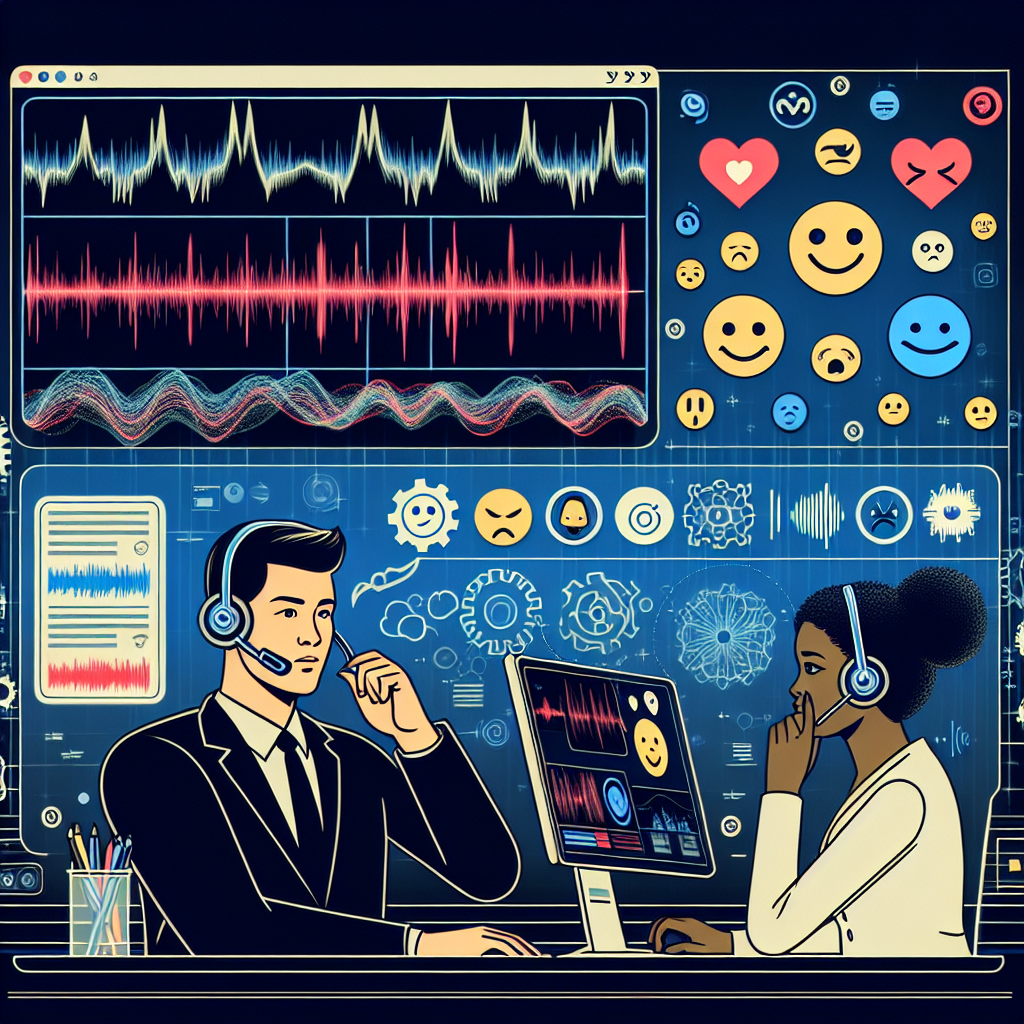
Understanding customer sentiments is integral to improving the overall customer experience. This brings us to the concept of Emotion Detection Technology and its increasing indispensability in voice communication. In today's digital age, this innovation functions as the invisible bridge that intuitively connects businesses with their customers, enhancing interaction and satisfaction.

Emotion Detection Technology, also known as Voice Emotion Analysis, comprises a variety of machine learning and artificial intelligence algorithms. These procedures, extensively explained by the Internet Society, aim to scrutinize and interpret the emotional states conveyed in a person's voice. Tone, pitch, volume, and speed serve as telling behavioral cues under analysis. Thus, the technology transcends the literal meaning of words, helping businesses delve into the underlying feelings of their clientele.
What makes this advent relevant in voice communication? It's simple: heightened customer understanding. Emotion detection technology allows companies to gauge customer sentiments during real-time interactions. Capturing unspoken complaints, enjoyment, frustration or satisfaction enables immediate response to enhance the customer's experience.
Your understanding doesn't stop here. The following sections take you further into the world of emotion detection in voice calls, discussing its benefits, applications, limitations, and future prospects.
In an era where customer communication has transitioned to non-physical interaction channels like voice calls, effectively understanding customer's emotional state during these interactions has gained paramount importance. Artificial Intelligence (AI) has been a significant catalyst in achieving this, as sophisticated AI algorithms are now being used to detect and interpret different emotional cues in voice calls.
Emotion detection in voice calls is a subfield of AI, often referred to as Emotion Recognition AI. This technology utilizes advanced machine learning algorithms to identify specific human emotions expressed during a voice conversation. The algorithms analyze various factors — tone, pitch, speed, and intensity of the voice — to accurately identify the emotion behind the words spoken.
AI plays a critical role in enhancing customer satisfaction by accurately identifying customer emotions. This intelligent detection allows service providers to dynamically adapt their responses in real-time, subsequently improving overall customer interactions. For instance, if the AI detects a customer's frustration in a voice call, the representative or AI chatbot can be alerted to handle the situation delicilately, taking necessary action to immediately resolve the issue and appease the customer.
Harnessing the power of AI in emotion detection during voice calls, businesses are able to anticipate customers' needs more effectively, build stronger relationships, and ultimately, enhance customer satisfaction. This technology goes above and beyond traditional communication methods and helps companies get closer to their customers by better understanding and responding to their emotional needs. In this digital age, AI-driven emotion detection is truly revolutionizing customer service interactions.
Emotion detection in voice calls, a feat made possible by recent advancements in artificial intelligence, can significantly revolutionize the customer service industry. This technology not only recognizes the words spoken in the call but also grasps the sentiment and emotion hidden in those words. As such, businesses are already leveraging these capabilities to boost customer satisfaction dramatically.

The primary benefit of emotion detection for customer service is that the technology equips operators with actionable insights into callers' emotional states. This understanding allows them to adapt their communication approach appropriately, thereby offering a more personalized and empathetic service. IBM's Watson, for instance, provides real-time emotion analysis to help service reps create more meaningful connections with customers.
Moreover, emotion detection technology can help identify calls that need urgent attention based on the emotions displayed by the customer. This sort of emotional triage can significantly impact customer satisfaction by ensuring that frustrated or angry customers are dealt with promptly and efficiently. Companies like CallMiner have successfully used emotion detection this way to reduce customer churn and increase customer loyalty.
Finally, the technology presents an opportunity for more robust post-call analysis. Rather than solely focusing on what was said, businesses can now delve into how it was said. Such comprehensive evaluation points can help businesses learn from their mistakes, identify Best Practices and continually enhance their customer service strategies.
Undeniably, incorporating emotion detection in voice calls can be a game-changer for businesses aiming for superior customer service. It presents an unprecedented level of understanding and connection, allowing businesses to take positive steps toward overall customer satisfaction.
As businesses seek to improve customer satisfaction, many are turning to emotion detection technology in voice calls. This advanced feature provides real-time insights into a customer's emotional state, enabling representatives to tailor their responses accordingly. However, implementing such technology is not without its challenges, and there are several essential considerations.
Technical Hurdiness
Firstly, emotional intelligence in artificial intelligence is a complex field. Despite remarkable advancements, there's still a high level of ambiguity and subjectivity involved. For instance, people express their emotions in myriad ways, varying by culture, personality, and mood. Accurately determining sentiment is an intricate task, which may lead to occasional misinterpretations.
Data Privacy and Ethical Concerns
Secondly, recording and analyzing voice calls for emotional content raises significant data privacy and ethical issues. In the era where data breaches and privacy violations are highly criticized, companies must ensure they’re transparent about the usage of this technology. Customers must be fully aware and have given consent before their emotions are monitored and analyzed.
Additionally, businesses need to carefully consider how they handle and store this sensitive data. As much as emotion detection can rationalize customer-employee interactions, it can also be perceived as intrusive and manipulative.
Furthermore, issues may arise in relation to how findings are interpreted and acted upon. For example, if the system detects anger, is it right to prioritize that call over another customer waiting patiently on the line? Companies must avoid creating a system that promotes a negative behavior and stress that respect and patience are equally valued.
Even with these hurdles, the benefits of emotional detection in voice calls can be significant. It's all about its careful implementation, with a deep regard for respecting customer privacy and ensuring a positive customer experience.
Industries across sectors are harnessing the power of emotion detection technology to improve customer satisfaction in voice calls. This promising technology enables companies to understand customers' sentiments during calls better, thus helping improve the overall customer service experience. Let's explore a couple of industry examples of how emotion detection technology has positively impacted their outcomes.

One notable example comes from the financial industry. CitiBank UK implemented Behavox's emotion detection solution and witnessed a significant increase in the successful resolution of customer complaints. The system flagged any negative emotions such as frustration and anger during the call, which allowed the representatives to address these sentiments proactively. As a result, the bank experienced a 40% decline in unresolved issues and a dramatic increase in customer satisfaction scores.
Next, consider an example from the telecommunications industry. T-Mobile USA adopted NICE's CXone emotion detection technology and made strides in delivering more empathetic customer service. The software used real-time emotion detection during calls, enabling the support team to handle situations more effectively. Subsequently, the company reported improved first call resolution rates and a decrease in customer churn rate by 15%.
Furthermore, the e-commerce giant, Amazon, has been utilizing Amazon Connect, their own emotion detection system, to provide superior customer support. This tool provides a real-time analysis of customer sentiment during voice calls, helping customer service agents to handle interactions more effectively. As a result, Amazon has reported higher customer satisfaction levels, with an impressive 20% increase in positive feedback.
These are just a few examples of how different industries are harnessing the potential of emotion detection technology in voice calls. With its proven ability to boost customer satisfaction, it's clear this technology is set to make waves across all sectors.
The advent and continual development of emotion detection in voice calls has revolutionized the realm of personalised customer service. As we look to the future, the possibilities grow increasingly exciting. Emotional AI is constantly adapting and innovating, and its potential for transforming the landscape of customer service is unparalleled.
Imagine a world where Intelligent Virtual Assistants (IVA) and chatbots not only process your requests swiftly but also read your emotional state to adapt their communication style effectively. This future of emotion detection may sound like a scene from a science fiction movie, but it is, in reality, the direction in which modern technology is headed.
The technological maturity of emotion detection from voice calls is expected to see remarkable advancements such as Emotive analytics, which goes beyond analyzing customer emotions during calls and covers the whole customer journey—touchpoints on websites, mobile apps to physical stores. Gartner suggests that by 2022, 10% of personal devices will have the ability to read our emotions.
In the future, business conversations will be distinctly human-like in their capacity for understanding and empathy. Whether it's an irate customer dealing with delay in service delivery or a confused client in need of technical support, sophisticated emotion detection software will be able to deal with all sorts of emotional statuses and provide more intuitive and empathetic services. This could revolutionize customer satisfaction and loyalty, setting new standards for business customer service practices.
The future of customer service is not just about quick resolutions and efficient service providers but also about empathetic and emotionally intelligent systems. Combining technological advancement with emotional understanding, emotion detection in voice calls might just be the holy grail of customer satisfaction.
Start your free trial for My AI Front Desk today, it takes minutes to setup!








